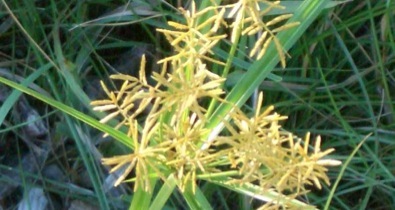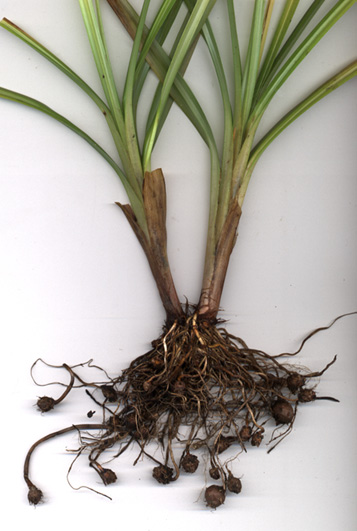Cyperus esculentus, C. rotundus: Serious Sedges
There are two edible Cyperus locally: One that tastes like hazelnuts and one that smells and tastes to me exactly like Vic’s Vapor Rub. Guess which one I happen to find more often?
Cyperus esculentus, the yellow nut sedge, is native to warmer parts of the Northern Hemisphere. It has been in use since ancient Egyptian times and is cultivated around the Mediterranean. The roots reach the size of hazelnuts and have a similar taste. They are excellent raw right out of the ground, boiled or roasted. Its tops are yellowish.
Cyperus rotundus, the purple nut sedge, is also edible raw but is laced with the VIC’s aroma which lessen on drying. However, before that they can be used as an insect repellant, a case of wear outside this week and eat inside next week. Its tops are purplish.
Chufa (CHOO-fah) Cyperus esculentus, the yellow nut sedge, is listed as a noxious weed in many places and difficult to control. It can produce hundreds of thousands of seeds per plant per season. Researchers say a single nutsedge can produce 1900 plants and 7000 tubers in a year. That’s a lot of food. And remember sedges have edges and these sedges have three sides, like a triangle. All sedge seeds are edible, according to Ray Mears and Gordon Brown.
In Egypt and the Mediterranean nut sedges were used as sources for food, medicine and perfumes. The tubers were usually roasted. Dried ground tubers were used to extend coffee and chocolate. Chufa oil was an ingredient in perfumed soap and a lubricant for fine machinery. The leafy parts were fed to livestock. A relative, Cyperus papyrus in Egypt, was the first source for paper there and is an escaped weed in many warm states. Here in Florida it is a common ornamental in water gardens. Interestingly, Chufas are very similar to olives in nutrition. The boiled nutlets are also good carp bait.
The genus name Cyperus (sye-PEER-us) is from Cypeirus which was the ancient Greek name for the plant. Esculentus (es-kyew-LEN-tus) means “edible” referring to the tubers. Rotundus (roh-TUHN-duh) means round.
Green Deane’s “Itemized” Plant Profile: Chufa
IDENTIFICATION: Cyperus esculentus: Annual monocot to three feet tall, solitary stems growing from a tuber, stems triangular bearing slender leaves one to three inches wide, flowers a cluster of flat oval seeds surrounded by four hanging leaf bracts at 90 degrees. Tough, fibrous, mistaken for a grass. It can be distinguished from other New World nutsedge by linear brown spiklets with overlapping scales
TIME OF YEAR: August to November
ENVIRONMENT: Old fields, cultivated ground, upland prairies, pond margins, stream edges, pastures, roadsides, railroads.
METHOD OF PREPARATION: Rub nutlet to loosen husk. C. esculentus edible raw or cooked. C. rotundus edible raw but better if allowed to dry a few days then consumed raw or cooked. Nutlets can be hard. Soaking in water eases that problem. All sedge seeds (on top) around the world are edible.
HERB BLURB
C. rotundus is used in Chinese medicine, especially pain associated with menstruation. It is also used for stomach aches and diarrhea, to treat impotence, bacterial infections, and dry or tired eyes. C. rotundus is also used as a diuretic and for high blood pressure. A paste of the plant is also spread on the skin as a bactericide and a fungicide to prevent infection of wounds. In two studies, compounds found in extracts from the root of C. rotundus were isolated and several have anti-malarial properties.



